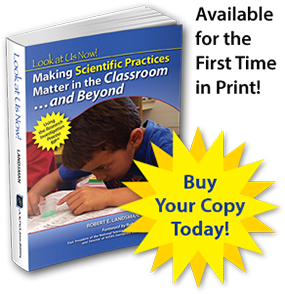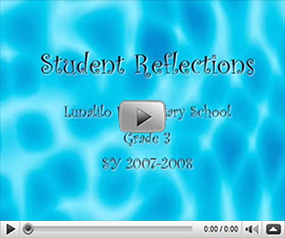Reviews
The reviews contained in this section were gathered from various sites across the Internet. Some of the reviews directly pertain to Look at Us Now! while others provide views about the Research Investigation Process (RIP®) while also including comments about this book.
If you have already read Look at Us Now! and wish to submit your own review, please click here.
Pictures are worth a million words and this book has plenty of charts, pictures of teachers and kids in action as they learn through inquiry, and tables and graphs describing data that students collected from their investigations. But more importantly, this book should help every teacher make the classroom content exciting and meaningful for their students. Eleven of the 13 chapters are written by teachers who are actually using science inquiry to teach STEM, language arts, mathematics, social studies, and science content. Mathematics is what most of the teachers I work with find to be the most challenging for completion of an investigation, and this book actually shows how each inquiry using the RIP scientific inquiry model ends with data collection, analysis, and supporting an argument with data, one of the most daunting standards for students and teachers. The teacher authors describe the challenges they encountered and how they overcame these challenges through more emphasis and less emphasis on some aspects of classroom environment, instructional practices, and student learning behavior. The RIP is clearly a data-driven education program that is research-based and can boast an enormous amount of student impact data. Chapter 12 written by Dr. Landsman describes these data for highly academically challenged and highly academically advantaged student populations. This book is a "must read" for any classroom teacher.
Look at Us Now! earns a "high-5" for quality of content, the Foreword, ease of use, layout, construction (including photos, tables, and graphs), and cover. The content covers how to manage scientific inquiry as an instructional practice in Grades Kindergarten to 12 classrooms. It features the Research Investigation process, a critical thinking approach that uses scientific inquiry. According to the editor, R. E. Landsman, PHD, scientific inquiry represents the practices that scientists use to learn about the world.
Robert Yager, PHD, a past president of the National Science Teachers Association (NSTA) and its current Director of Exemplary Programs, wrote the Foreword which argues the importance of the "How" and "Why" versus the What in teaching. According to Professor Yager, the new national science standards called the Next Generation Science Standards will not be possible to achieve unless the same More Emphasis conditions are addressed that were required by the older previous national science standards (NSES). He feels that this book demonstrates that with the appropriate teacher training (in this case with the RIP model) teachers are able to achieve these More Emphasis conditions required to occur in order for the standards to be addressed.
Chapter 1 was written by Landsman (a research scientist and developer of the RIP scientific inquiry model) and Kamimura (a teacher) and introduces the RIP model. It briefly describes how the teacher authors of the chapters used the RIP model of scientific inquiry to achieve these necessary conditions that resulted in them successfully addressing science, mathematics, STEM, language arts, social studies, and other education standards.
Ten of the chapters were written by classroom teachers who describe how they brought this model into the classroom, the challenges they faced implementing inquiry-based teaching, and how they faced and conquered the conditions necessary for successfully meeting educational standards (More Emphasis conditions). The book as a whole serves as a tool chest of ideas. Each teacher not only identifies the More Emphasis conditions as they happened, but also what they changed or added to achieve those conditions.
It is very important to read the lead chapter and the How to Use This Book section to get the most out of the teacher's chapters.
Landsman also wrote the two last chapters, one of which was reprinted from the "Exemplary Science Series" book from NSTA, that present results in the form of assessment, quantitative and qualitative data, and lasting impact from this program beyond high school. The NSTA reprinted Chapter 12 portrays how a very challenged and a very advantaged school demonstrated similar successes implementing the RIP. It also presents an extended results section not published in the NSTA published version that supplies assessment and evaluation data on a website. The final chapter, also written by Landsman summarizes the More Emphasis conditions covered in the Chapters and the data presented.
The photographs contained in each chapter of the book depict what is described in the text: Actual classroom scenarios, real data from classroom student-led investigations in the form of graphs and tables, and students who appear excitedly learning through this approach.
This book is exciting and informative. As a former scientist and classroom teacher, I give this book a thumbs-up for all working in the field of education, including K-12 teachers, instructional support staff, principles, and superintendents.
Your Shopping Cart
Ordering five (5) or more copies? Contact us for a special volume discount.
Read the Foreword
Enter your name and e-mail address below for immediate access to read the complete Foreword, written by Dr. Robert E. Yager, in its entirety.


 ANOVA Science
ANOVA Science